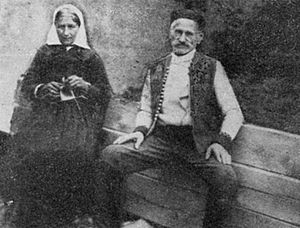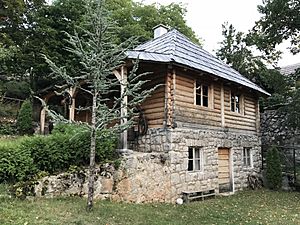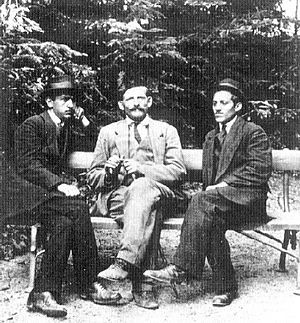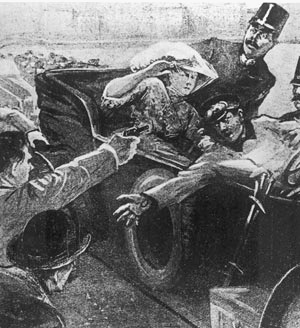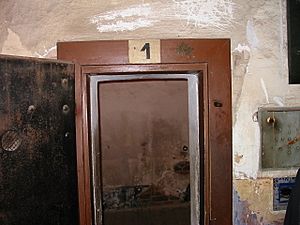Gavrilo Princip facts for kids
Quick facts for kids
Gavrilo Princip
|
|
|---|---|
| Гаврило Принцип | |
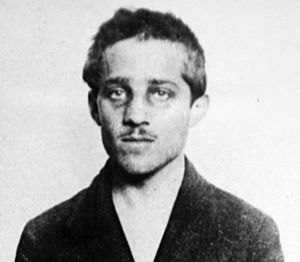
Princip in his prison cell c. 1915
|
|
| Born | 25 July 1894 |
| Died | 28 April 1918 (aged 23) Terezín Fortress, Bohemia, Austria-Hungary
|
| Resting place | Vidovdan Heroes Chapel, Sarajevo |
| Known for | Assassination of Archduke Franz Ferdinand |
| Conviction(s) | High treason Murder (2 counts) |
| Criminal penalty | 20 years imprisonment |
| Signature | |
 |
|
Gavrilo Princip (Serbian Cyrillic: Гаврило Принцип; 25 July 1894 – 28 April 1918) was a Bosnian Serb student. He is known for assassinating Archduke Franz Ferdinand of Austria and his wife Sophie, Duchess of Hohenberg. This happened in Sarajevo on 28 June 1914. Many historians believe this event helped start World War I.
Contents
Early Life and Education
Gavrilo Princip was born in a small village called Obljaj. This was near Bosansko Grahovo in 1894. His family was poor and he was one of nine children. Sadly, six of his siblings died when they were babies. Gavrilo was a sickly baby himself. A local priest suggested naming him after the Archangel Gabriel, hoping it would help him survive.
Princip started primary school in 1903 when he was nine years old. He had a tough first year but then became a very good student. His headmaster even gave him a collection of Serbian poems as a prize.
When he was 13, Princip moved to Sarajevo. This city was the capital of Austrian-controlled Bosnia. He went to a Merchants’ School there. His older brother, Jovan, paid for his schooling. Jovan worked hard carrying logs from the forests to mills in the city.
After three years, Gavrilo moved to the Sarajevo Gymnasium, which is like a high school. Here, he became interested in politics. In 1911, he joined a secret group called Young Bosnia. This group wanted to free Bosnia from Austrian control. They also wanted to unite all South Slavs, who are people from countries like Serbia, Croatia, and Slovenia.
In 1912, Princip took part in protests against Austria in Sarajevo. Because of this, he was kicked out of school. He then walked to Belgrade, which is in Serbia, to continue his education. He tried to pass an exam at the First Belgrade Gymnasium in June 1912, but he failed.
During the First Balkan War, Princip tried to join the Serbian army's special forces. They were fighting against the Ottoman Empire. However, he was rejected because he was too small and weak.
In the summer of 1913, Princip passed his high school exams for two grades. In early 1914, he left Sarajevo for Belgrade. He stopped in his village to see his parents. While in Belgrade, he was preparing for more exams. His friend Nedeljko Čabrinović showed him a newspaper article. It announced that Archduke Franz Ferdinand would visit Bosnia in June. Princip then decided to plan an attack on the Archduke during his visit to Sarajevo.
The Assassination Plot
Princip convinced his friends Milan Čabrinović and Trifko Grabež to join his plan. A secret Serbian group called the Black Hand helped them. This group had connections to Serbian military intelligence. They gave the young men weapons and training. They also helped them travel to Bosnia.
On Sunday, 28 June 1914, the Archduke and his wife visited Sarajevo. Six young men involved in the plot waited with bombs and guns for Ferdinand's car to pass. All of them failed to act.
Suddenly, Princip saw Ferdinand in his car. The driver had taken a wrong turn and stalled the car while trying to turn around. Princip walked up to the car and shot Ferdinand. He had wanted to shoot a general who was also in the car. But Ferdinand's wife, Sophie, threw her arms around her husband. She was in the way, and Princip shot her instead of the general.
Arrest and Trial
Princip was arrested right away. He was tried along with twenty-four other people. All of them were Bosnians and subjects of Austria-Hungary. During his trial, Princip said: "I am a Yugoslav nationalist, aiming for the unification of all Yugoslavs, and I do not care what form of state, but it must be free from Austria."
Princip was not given the death penalty. This was because he was only 19 years old. Instead, he was sentenced to twenty years in prison. He was sent to the Terezín fortress in northern Bohemia, which is now in the Czech Republic.
The Start of World War I
Because of this assassination, Austria-Hungary gave Serbia a list of demands. This list was called the "July Ultimatum". Austria-Hungary wanted Serbia to stop groups like the Black Hand. Serbia could not meet all the demands quickly enough. Austria-Hungary really wanted to go to war with Serbia, and their German allies also wanted a big war. This led many European countries to start fighting each other.
Many historians believe that the assassination of Franz Ferdinand was the event that started World War I.
Imprisonment and Death
Princip was kept in solitary confinement, chained to a wall. He died on 28 April 1918. He had tuberculosis, a serious lung disease. This was caused by the terrible conditions in the prison. He had already lost his right arm because of his illness.
Prison guards secretly buried Princip in an unmarked grave. They were afraid that his bones might become important to Slavic nationalists. But a Czech soldier who helped with the burial remembered where it was. In 1920, Princip and other "Heroes of Vidovdan" were dug up. They were brought to Sarajevo and buried together. They rest beneath the Vidovdan Heroes Chapel at the Holy Archangels Cemetery. This chapel was built to remember these Serb heroes forever.
Legacy and Memorials
Even after his death, people still disagree about Gavrilo Princip. For the Habsburg monarchy (the Austrian rulers) and their supporters, he was a dangerous terrorist. But in Royal Yugoslavia, he was seen as a Yugoslav hero.
In the 1990s, some people started to see Princip as a Serbian nationalist. They believed he acted to create a Greater Serbia. Different political groups have either praised him or called him evil. They do this to support their own ideas.
Today, many Serbs still see him as a hero. However, many Croats and Bosniaks consider him a terrorist.
The house where Princip lived in Sarajevo was destroyed during World War I. After the war, it was rebuilt as a museum in the Kingdom of Yugoslavia. When Germany took over Yugoslavia in 1941, the Croatian Ustaše destroyed the house again. After Communist Yugoslavia was formed in 1944, Princip's house became a museum again. There was also another museum about him in Sarajevo. During the Yugoslav Wars in the 1990s, Princip's house was destroyed a third time. It was rebuilt again in 2015.
Princip's pistol was taken by the authorities. It was later given to Anton Puntigam, a priest who was a friend of the Archduke. The priest had given the Archduke and his wife their last prayers. The pistol and the Archduke's blood-stained shirt stayed with the Austrian Jesuits. In 2004, they were loaned to the Museum of Military History in Vienna. They are now part of the museum's permanent display.
During the time of Yugoslavia, the Latin Bridge, where the assassination happened, was renamed Princip's Bridge. It went back to its old name, Latinska Cuprija, in 1992. In Sarajevo, about six memorials to Gavrilo Princip have been put up and then torn down as power changed hands.
In 1917, a pillar was built at the corner where the assassination took place. It was destroyed the next year. In 1941, a plaque from 1930 remembering Princip was removed by local Germans. It was given to Adolf Hitler as a birthday gift and kept in a museum. It was lost after 1945. After World War II, a new plaque was put up. It said that "Gavrilo Princip threw off the German occupiers." During the Bosnian War, footprints marking where Princip fired the shots were removed.
As the 100th anniversary of the assassination came closer, a neutral plaque was put up at the corner. It says: "From this place on 28 June 1914, Gavrilo Princip assassinated the heir to the Austro-Hungarian throne Franz Ferdinand and his wife Sofia." On 21 April 2014, a statue of Princip was revealed in Tovariševo. On the actual anniversary, another statue was put up in East Sarajevo. A year later, a statue of Princip was revealed in Belgrade. The President of Serbia, Tomislav Nikolić, and the President of Republika Srpska, Milorad Dodik, unveiled it. It was a gift from Republika Srpska to Serbia. At the unveiling, Nikolić said that "Princip was a hero, a symbol of liberation ideas, tyrant-killer, idea-holder of liberation from slavery, which spanned through Europe."
On 11 November 2018, which was 100 years after World War I ended, Princess Anita of Hohenberg and Branislav Princip shook hands. Princess Anita is the great-grandchild of Archduke Franz Ferdinand. Branislav Princip is the grandnephew of Gavrilo Princip. This handshake in Graz, Austria, was a symbolic act of making peace.
In Film
Gavrilo Princip has been shown in several films:
- In the German drama film 1914 (1931), Carl Balhaus played him.
- Irfan Mensur played Princip in The Day That Shook the World (1975), which was based on the assassination.
- He was played by Eugen Knecht in Sarajevo (2014), a German-Austrian TV movie.
- Joel Basman played him in The King's Man (2021), a film in the Kingsman series.
Images for kids
See also
 In Spanish: Gavrilo Princip para niños
In Spanish: Gavrilo Princip para niños


